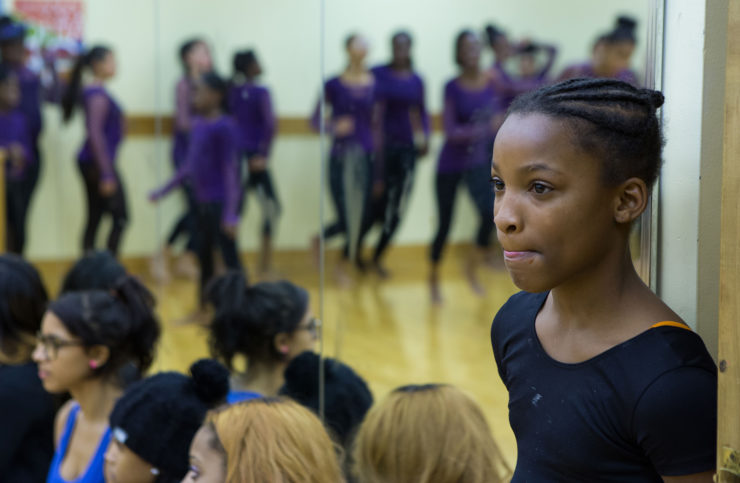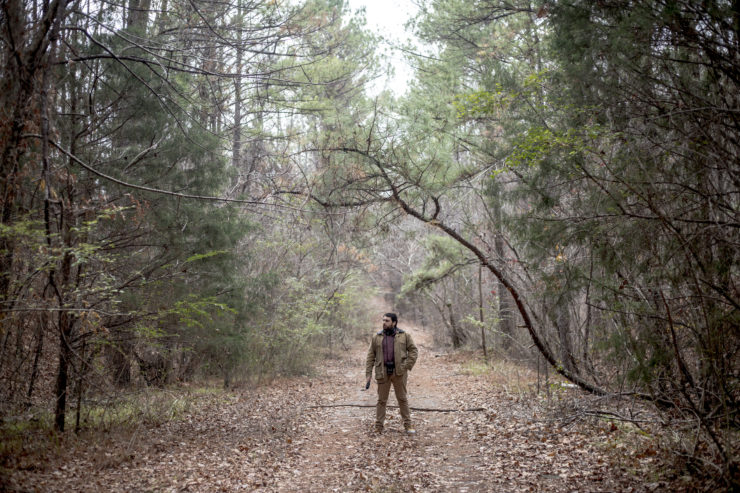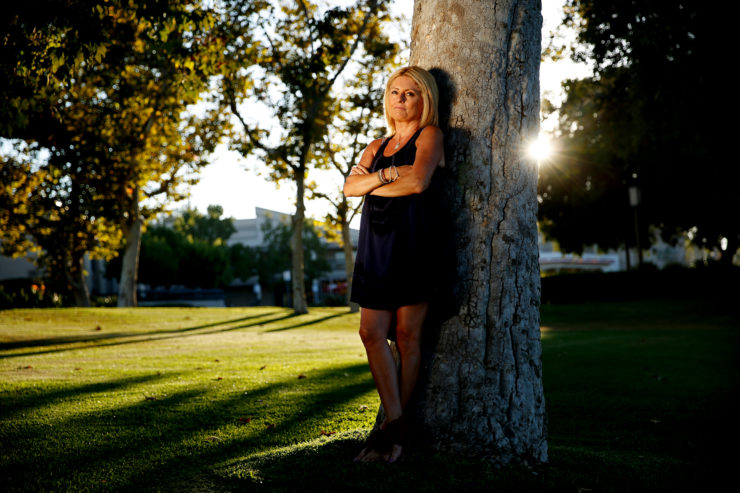
The New York Times’ five-part serial “Invisible Child”—which chronicled the life of a homeless girl, Dasani (shown here), and her family—took Andrea Elliott more than a year to report and write.
When Colin McNulty was developing a podcast about Oprah Winfrey, the producer for WBEZ Chicago found inspiration in an unlikely place: “House of Cards,” the Netflix series about a scheming Washington politician who eventually becomes president of the United States.
It’s not that Winfrey, the billionaire high priestess of “living your best life,” reminded him of the fictional Frank Underwood, the Netflix series’ villainous main character. But the structure of the series’ first three seasons, replete with cliffhangers and plot twists as Underwood rises from congressman to vice president to president, seemed a good template for a three-episode podcast chronicling Winfrey’s journey to the pinnacle of success.
“Making Oprah” begins with a dramatic moment as prologue: the demolition of her Chicago Harpo Studios in July 2016, five years after her show ended, to make way for a new McDonald’s corporate headquarters. The first episode, “No Strategy, No Plan, No Formula,” then circles back to tell the story of her beginnings as an African-American woman in television news and how she managed to wrangle her way into her first talk show. The episode ends on a dubious 1988 turning point: Winfrey drags on stage a wagon filled with 67 pounds of animal fat, which represents the weight she has lost. She shows off a svelte new body that didn’t last—a move that ended up haunting her.
The second episode, “Skinheads and Scented Candles,” chronicles her soul-searching after she realizes that a show featuring white supremacists gave a powerful platform to people whose ideas she abhorred. She decides she must take responsibility for the influence her show exerts and determines to find a new, more inspirational identity.
America’s love of television binge-watching has reinvigorated a literary form, the serial narrative
The final episode, “YOU GET A CAR!”, explores the consequences of unbridled success as the whole enterprise becomes more outrageous—with stunts like giving out free cars to everyone in the audience. Finally, Winfrey and her staff decide they risk becoming a parody of themselves, so they make the difficult decision to end the program.
Joel Meyer, WBEZ executive producer for talk programming, says “Making Oprah” has been the station’s most successful podcast launch. “The story of how she kept evolving her show and how she tried to turn it into more than a talk show was really appealing to a lot of people,” Meyer says.
The surprising success of “Making Oprah,” on the heels of “Serial,” the 2014 “This American Life” podcast phenomenon, shows how America’s love of television binge-watching has reinvigorated a literary form, the serial narrative, with a history that dates to Dickens and Homer. Nonfiction serials have animated screens, radios, and even daily newspapers.
Long-form serials run counter to the super-short tweeting and microblogging trend. But it’s not the length that makes a serial enticing, it’s what Indiana University journalism professor Thomas French calls “the enforced waiting.” This “to be continued” approach draws in readers using the classic tools of storytelling craft that focus more on creating narrative tension than on conveying information.
Episodes of the first two seasons of “Serial” have been downloaded more than 250 million times, and it became the first podcast to win a Peabody Award. The “Serial” team’s newest podcast debuted to generally glowing reviews on March 28. “S-Town” is a seven-episode series about a possible murder in rural Alabama hosted by “This American Life” producer Brian Reed. Unlike the original two seasons of “Serial,” which were released weekly, “S-Town” listeners could download all seven episodes at once. Although “S-Town” is not a straightforward “true crime” story like the original “Serial,” its psychologically complex story struck a chord with listeners. In the first four days of its release, “S-Town” had been downloaded more than 10 million times—a record for a podcast, according to Serial Productions.
Although serial podcasts are popular to produce because they are a relatively inexpensive way to attract advertising dollars, the timeless draw of serial narrative permeates print and film as well. The documentary “OJ: Made in America,” created as an approximately 7½-hour movie for theaters but presented on ESPN as a five-part television serial, was rebroadcast on ABC and ESPN2; 41 million viewers tuned in to one of the 40 telecasts of the documentary between the June 11 premiere and July. Viewership grew even higher after it won an Academy Award in February. (Read a Storyboard interview with director Ezra Edelman here.)
Newspapers in search of readers also seem occasionally willing to invest the time needed—often a year or more—to produce deeply reported series that deliver subscriptions and pageviews. The New York Times’ 2013 five-part serial “Invisible Child” took Andrea Elliott more than a year to report and write. The Los Angeles Times’ 2016 “A Mystery in Six Parts,” called “Framed,” attracted 3 million unique pageviews and 50,000 subscribers to its newsletter.
Even book publishers, looking to reach a wider audience, have turned historical nonfiction into unconventional serial narratives: “March,” Georgia Congressman John Lewis’ story of his journey through the civil rights movement, is a New York Times bestselling three-volume graphic novel that is now being read in schools.
“A serial is not a form of information delivery,” says Roy Peter Clark, the Poynter Institute’s senior scholar and one of the nation’s most ardent nurturers of narrative journalism. “It’s a form of experience delivery. Whether it’s nonfiction or fiction, it’s the creation of a world.”
From Dickens to Netflix, a primary question drives good storytelling: What happens next? New York Times television critic James Poniewozik calls it “the suck, where you’re sucked into it, and you just want one more bite.” “Serial” captured this feeling in its first season when it sowed doubt about convicted murderer Adnan Syed with this question: Is he really guilty? The search for an answer, with reporter Sarah Koenig as a truth-seeking character in the narrative, unspooled over the course of 12 episodes and resulted in a new trial for Syed.

"S-Town" host Brian Reed. Within four days of its release, the podcast was downloaded more than 10 million times
How does a journalist create a compelling world, and keep the reader asking for more? The tools are no different from nonfiction’s and fiction’s basics: inciting incident, narrative arc and scenes including dialogue that move the narrative forward. When translating journalism into serials, some subject matters seem a natural: true crime, life-and-death struggle, a compelling character triumphing over obstacles.
French, a Pulitzer Prize-winning practitioner of narrative storytelling, advocates finding an “engine” for a nonfiction narrative, “a question that drives the story that cannot be resolved in the cycle of one day and one night.” This question forms the story’s arc and can only be answered by continuing to read.
Of course, adding the constraints of journalism into the mix of creating a compelling story arc complicates the matter. For example, “Serial” may have been great storytelling, but it has been criticized for lax reporting and a tendency to sensationalize in service of the mystery narrative. Koenig fails to interview key players and inserts herself into scenes that seem to revolve around her own feelings and not reported facts.
“To do a serial well requires a tremendous amount of reporting,” says French, who is best known for the serial narratives he wrote for The St. Petersburg Times. “In a lot of journalism we are content to say, ‘Such and such happened, police said.’ When you do a serialized narrative, you have to actually find out what really happened.”
Both reported reconstruction—using documents, videos and other artifacts—and eyewitness observation can form the details of a narrative. But unlike fiction, where the writer is in complete control of the story, a journalist must come to terms with a story that may not be perfect. “Real life doesn’t unfold as seamlessly as fiction,” French says. “It’s a lot more complicated, and very often has no real ending. You have to make your peace with the unruliness of real life.”
“A serial is not a form of information delivery. It’s a form of experience delivery. Whether it’s nonfiction or fiction, it’s the creation of a world.” —Roy Peter Clark
The story behind a serial narrative doesn’t have to be new, but it does need to be told in a fresh way. When Los Angeles Times reporter Christopher Goffard decided to follow the bizarre story of a Southern California PTA mom’s harrowing experience with a false accusation, he knew he was taking on a sensational case that had already had its share of media attention. Still, “Framed,” published in September 2016, managed to keep readers on edge. The subhead teased at what was to come: “She was the PTA Mom Everyone Knew. Who Would Want to Harm Her?” An astute use of online tools also added freshness and transparency. Web designer Lily Mihalik incorporated document excerpts, and short audio and video clips of the main characters.
Clark argues that sometimes hyperlinks and other temptations of online publishing can sabotage a narrative because they take people out of the story. “Digital and multimedia versions of journalism have deemphasized the linear aspect of the reading experience,” he says. “With the hyperlink alone, you’re inviting people to stop moving forward and asking them to start moving sideways.” But in “Framed” the immediacy of being able hear the main characters’ voices and see the court documents seemed to add excitement and keep readers engaged. In a description of the series in a Facebook event with Goffard, readers called the serial “bonkers,” “highly addictive” and “juicier than a Mexican novella.”
Goffard first covered the story when it broke years earlier: A power couple, both attorneys, was charged with an unlikely revenge crime that sounded like tabloid fare. They were accused of planting 17 grams of marijuana, 11 Percocet and 29 Vicodin pills in the car of a volunteer director of an after-school program in Irvine, California. The wife pleaded guilty to a felony count of false imprisonment by fraud or deceit. A jury found the husband guilty of one count of false imprisonment by fraud or deceit. Goffard dug back into the story in early 2016 when he encountered the husband, sitting alone and looking defeated, at a courthouse where he was defending himself against the civil lawsuit the PTA mom had filed.
From Dickens to Netflix, a primary question drives good storytelling: What happens next?
After discussing the encounter with his editors, Goffard decided it was a story worth telling again, this time in more depth: “Some people said, ‘That’s an old story. Hasn’t it been told?’ But it raised all kinds of interesting themes about the power dynamics of Southern California suburbia and the mysteries of self-destructive behavior and the nightmare of false accusation, and it really hadn’t been told.”
The story, 15,000 words long, was originally going to run into two parts, but Times editor-in-chief Davan Maharaj suggested breaking it up into smaller segments. Goffard found that it divided naturally into six chapters, with each one running from about 1,800 to 3,100 words. “What’s fun about six parts is the series builds momentum and word of mouth, especially on social media,” Goffard says.
He tried to end on cliffhangers, and the end of the first installment was a classic, a recreated conversation between the investigating police officer and the PTA Mom:
He had asked Kelli Peters:
If the drugs aren’t yours, how did they get in your car?
“I have an enemy,” she said.
Although it seems at first that the narrative tension will revolve around whether the PTA mom is guilty, it becomes clear very quickly that she’s not. “The question of whether she’s innocent is not the basis of the suspense here,” Goffard explains. “She’s obviously innocent. The question is, ‘Who set her up?’ When that gets answered, the question is, ‘Why?’ And then, ‘Will the law be able to do anything about it?’ And then, ‘Will the full truth ever come out?’”
Because this is real life and not fiction, the biggest questions of the series never really get answered: Why did a seemingly happy and well-to-do couple of lawyers target a do-gooder PTA mom in such a vicious way? Goffard admits he’s still baffled: “I don’t have any real answers to that one beyond what’s in the story.”

Though Kelli Peters, shown here, had already received plenty of media attention after drugs were planted in her car, LA Times reporter Christopher Goffard knew her story could be told in a fresh way through a serial narrative
Serial narratives blossomed with the New Journalism of the 1970s, when writers like Tom Wolfe and Gay Talese used literary techniques to tell nonfiction stories. In the 1990s, profitable newsrooms devoted money and time to reporters who produced what would come to be considered masterworks of the newspaper serial form. In 1991 at The St. Petersburg Times, French wrote a Livingston Award-winning serial,“South of Heaven,” using the chronological frame of one year in a south Florida high school to create narrative tension with this question: Who will drop out and who will graduate? He later was awarded the 1998 feature writing Pulitzer Prize for “Angels and Demons,” a St. Petersburg Times serial that chronicled the murder of an Ohio woman and her two teenage daughters as they vacationed in Tampa.
Mark Bowden also found inspiration in the New Journalism techniques, even though his editors were pleading with him to write so short that his stories wouldn’t jump to an inside page. Bowden, who began working at The Philadelphia Inquirer in 1979, discovered the power of “long” in the 1990s when he deconstructed a book he was working on and turned it into a 26-day newspaper serial about how a U.S. relief mission in Somalia ended in a firefight with high-tech helicopters.
Bowden had been working on the book on his own but couldn’t find a publisher. He negotiated a deal with his editors that he would chop it up into a newspaper serial. It took him about a year to get it into shape. He focused on the dramatic action of the events, and cut out most of the analysis, until it was about a third of the size of the original manuscript. Each day’s installment was about 25 newspaper inches, and he tried to write scenes because he knew scenes move a story forward. “If you can write a scene with character, that is the most fun to read,” says Bowden, who is now an author and a writer in residence at the University of Delaware.
This was the early days of newspaper’s online presence, and a visionary online editor, Jennifer Musser Metz, decided to present all of Bowden’s source material. He remembers bringing in shopping bags full of documents that were then posted online in a multimedia presentation. In an exhibit at the Newseum in Washington D.C., the online display is credited with being one of the earliest examples of its kind.
It was a hit both in the paper and online. The series, called “Black Hawk Down,” became an Internet phenomenon. Hollywood producer Jerry Bruckheimer turned it into a blockbuster film directed by Ridley Scott.
But most surprising, Bowden recalls, the head of circulation ventured into the foreign territory of the newsroom to shake his hand. “Do another one like this,” he said.
A serial doesn’t only answer the question: What happened next? Sometimes, it also explores a second, deeper question : How did it happen?
When producer Caroline Waterlow got a call from director Ezra Edelman asking if she wanted to work on a documentary about O.J. Simpson, she recalls saying, “Really? Do we need more about O.J.?” And she remembers his response: “It’s not just about O.J. — it’s about everything!”
Waterlow says she was convinced to sign on when Edelman described his vision for a documentary that used the prism of race to intertwine O.J.’s history and the city of Los Angeles’ history and explore how they culminated in that moment when O.J. was acquitted. The finished product was what French would call a “multi-thread” narrative, with O.J. and L.A. as the two main characters. It spans half a century and is told mostly in straight chronological order that braids together O.J.’s rise from a San Francisco housing project to star athlete, pitchman, and actor with the history of the L.A. Police Department’s fraught relationship with the city’s African-American citizens.
Serials offer a break from 24/7 information overload by inviting an audience to slow down and savor a story
The team worked on the film for two years, conducted 72 interviews, shot 300 hours of original material and sifted through 500 hours of archival footage. The New York Times’ Poniewozik says one of the most memorable scenes is 1970s footage of a Hertz commercial in which O.J., the Heisman Trophy winner, is sprinting through an airport to get his rental car. In the background, “white validators” in the form of an elderly white woman and a group of young white Girls Scouts cheer him on. Poniewozik calls the film a “documentary essay” more than a classic “true crime” narrative.
“It’s telling this very familiar story and telling you, ‘This is why it mattered,’” he says. “Why did it matter that O.J. was a black celebrity, and why in the context of civil rights in America and popular culture?”
Waterlow says the film was not conceived as a serial and Edelman would have preferred that viewers only watch in a theater with an intermission or two. Its serialization resulted from the realities of television, but the chronological structure lent itself to natural chapter breaks, and producers didn’t have much trouble dividing it into five parts. Although each part didn’t end on a traditional cliffhanger, the questions asked were interesting enough to hook the audience. “The length was the whole point,” says Waterlow. “Ezra’s interest was in a large canvas. There was no point of doing another two-hour film because that had been done. We were told no one’s got time, but the reaction was really strong. People were hungry for this.”
The “Making Oprah” podcast capitalizes on Oprah’s fame and the genuine excitement of its host, WBEZ anchor Jenn White, an African-American woman who at one point in the podcast calls her mother just to tell her she is going to speak to Winfrey. Making the reporter part of the story works, McNulty says, because “it breaks up the authority, makes it a little more approachable, and makes the audience feel like they’re being let in on stuff.”
Roy Peter Clark calls this technique “broken narrative.” He likens it to one used by John McPhee’s classic “Coming Into the Country,” a nonfiction account of traveling through Alaska. In the book, the reader follows McPhee as he journeys down a river, until McPhee steps out of the flow to tell the reader how he got there. Podcasts like “Making Oprah” and “Serial” work despite the broken narrative, Clark says, because “the story is compelling enough that the audience wants to stick with it.”
In the current media environment, serials offer a break from 24/7 information overload by inviting an audience to slow down and savor a story. “That’s one thing that Netflix and podcasts have shown us,” says Poniewozik. “If people are enthusiastic about something, they will spend a lot of time with it.”


